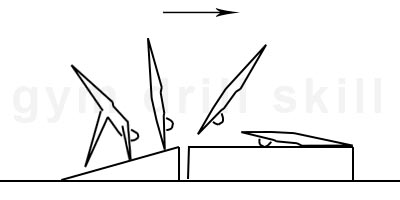


The gymnast should gradually accelerate as they get closer to the springboard. At the final step of the run, the gymnast should jump onto the springboard. This jump should remain low and long with their arms circling backwards. There should be a strong push from their legs against the board as their arms are swung forward into the take-off. During the flight onto the table, the gymnast’s heels should lift strongly and their arms should reach quickly to make contact with the table. The body should be slightly arched or straight, and should rotate around the hands. The block with the arms and shoulders must occur just before the handstand position. The gymnast’s head should be slightly backwards. The gymnast’s body should remain slightly arched during the flight phase, and the degree of rotation should be controlled by moving the arms upward or to the side. During the landing, the feet should land in front of the body. The gymnast’s legs, hips, and ankles should bend to control the landing.

The gymnast should run several steps, hurdle, lunge and put their hands on the floor at a comfortable distance. Their hands should not be too close to the lunging leg, and they shouldn’t jump before putting their hands on the floor. The gymnast should have a strong kick from their back leg, an at the same time they should push off their lunge leg. This helps to increase the speed of the rotation. By the handstand position, the gymnast’s legs should snap together. Following this position is a strong blocking action from the shoulders and hands. In the flight after handstand, the gymnast’s body should be extended and tight. The gymnast should keep their eyes on their hands from the moment they put them on the floor, until they land standing with their arms up.

To perform a dive roll, the gymnast should run, gradually increasing their speed. They should punch off the floor with their legs tight and feet together. They should jump into the air with a straight body. At the moment of the punch, the gymnast’s arms should do a back circle and swing upwards. This arm motion will help to increase the height of the jump. After the jump the gymnast should arch their body slightly while kicking their legs backwards. They should keep their chin up with their arms slightly bent out to the side. The kick from the gymnast’s heels will help to flip them forwards. When the gymnast reaches the floor, they should be in a nearly vertical position. They should bent their arms slightly, roll forward and stand up.

This skill helps the gymnast understand how to perform a better heel drive (kick). It also improves their straight body position and punch off the ground. The gymnast should keep their legs tight and execute the skill in an upward motion. The gymnast’s arms should be used to set.

The gymnast should run and gradually increase their speed. They should perform a hurdle onto the springboard with their arms making a back-circle motion. The gymnast should rebound with their arms up, executing a slight stretch jump during the flight. They should land to a controlled position on the mat with their arms in front of their shoulders.

From a standing position, the gymnast should step forward, lunge and put their hands on the floor. Their back leg should have a strong kick backwards while their lunging leg pushes against the floor. The lunging leg should reach the back leg by the time the gymnast is in the handstand position. Following this comes a blocking action. The body should release upwards in a vertical position, finishing in a handstand. This drill helps improve the gymnast’s ability to kick with the back leg and increase the amplitude of the blocking action.

The technique for this drill is similar to the handstand rebound exercise. Place a cheese mat next to one or more 8 inch mats. Have the gymnast kick up to handstand, execute a blocking motion, and land flat on their back with a tight body.

The gymnast should perform a relatively short run. The jump onto the springboard should be low, with their arms circling backwards. There should be a strong push from the legs against the board as the arms are swung forwards and upwards into the take-off. The gymnast’s hands should reach the resi-mat before the body is in the handstand position. Following this should be a strong block in the handstand resulting in the take-off. The body should be extended and tight. The skill finishes when the gymnast lands flat on their back. This drill helps to emphasize the jump on the springboard and blocking action onto the mat.

The gymnast should execute a short run and jump onto the springboard. The jump should be low, with their arms circling backwards. There should be a strong push from the legs against the board as the gymnast’s arms are swung forwards and upwards into the take-off. In the flight onto the platform, the gymnast should lift their heels strongly and reach their arms quickly to make contact with the vault table. The body should be slightly arched or straight. This drill emphasizes the jumping technique and kick (heel drive) from the legs.
Integral part of gymnastics coaching process are skill drills. They help gymnasts to learn easier and technically correct. With GYM DRILL PRO you will find variety of ideas for the most the basic gymnastics skills. There are plenty of images with skill drill progressions. It is intended to support explicitly the qualified coaches in their daily coaching business. DO NOT practice without the guidance of proper professionals.